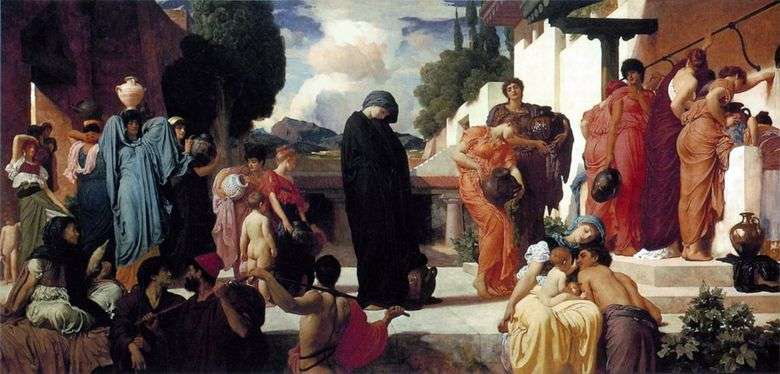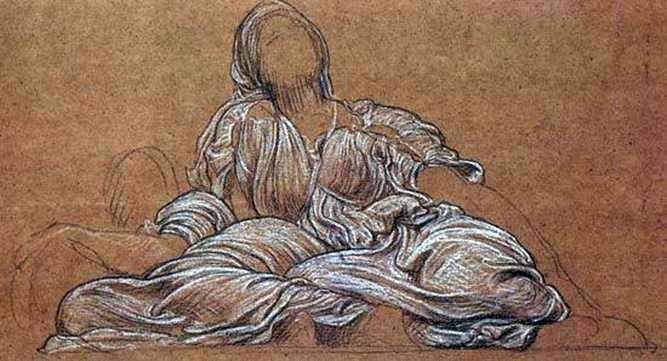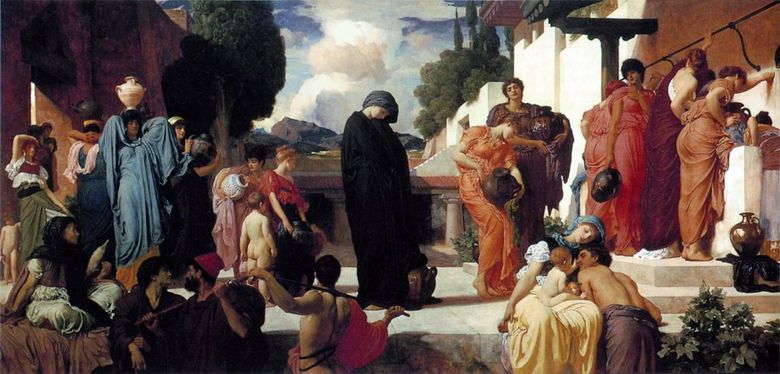
The plot of this picture was inspired by Leyton excerpt from the Iliad, in which Hector, one of the heroes of the Trojans, is trying to “predict” the fate of his wife, Andromache, if he falls on the battlefield. “I see you,” says Hector, “watering the fields of others from another well, deprived of the right to straighten his back, deprived of his own will.” The composition of “Captive Andromache” Leighton builds up like a frieze, rhythmically arranging the figures across the entire width of the picture.
In the center of a symmetrical composition, the artist places the tragic, dressed in black, Andromache. She looks lonely, isolated from others. Her sorrowfully bowed head stands out against the background of a distant landscape and a cloudy sky. The linear rhythm of the picture is underlined by color transitions. The color changes from cold in the left part of the picture to warm in its right part. The figure of Andromache interrupts the smooth flow of color waves, in sharp contrast with everything around him. In the foreground of “Captive Andromache” Leighton placed a happy family – a mother, a father and a baby. These three, intoxicated with their happiness, should emphasize the depth of the grief of Andromache, who lost both her husband and son.
We cannot determine exactly where Andromache’s gaze is directed. But it is quite possible, she looks precisely at this carefree family scene, which reminds her of the best days in her life. Leighton worked on his paintings for a long time, making many drawings, carefully building a composition. By “Captive Andromache” master created about sixty sketches. Like a choreographer, he “put” his multi-figured canvases, specifying in the drawings the postures of the characters of the future picture and stretching invisible threads between them, which were supposed to tie all the composite parts together. Human figures Leighton always wrote only from nature. At the same time, he first wrote them naked and only then “dressed”, seeking anatomical accuracy.
Having made preliminary compositional drawings and sketches of figures, the master proceeded to the “final” sketches. Leighton said that they “must be absolutely accurate, because later they have to be transferred to the canvas in squares.” One of such etudes, graded into squares, to “Captive Andromache” is dated 1887. This study shows that the author specified the composition even at this stage of work. In particular, the head of the mother, holding the child in her lap, at first was not inclined towards the shoulder. The artist found this position, having already transferred the sketch to the canvas.
 Study for the composition “Dance” by Frederick Leighton
Study for the composition “Dance” by Frederick Leighton Andromache capturado – Fredekik Leighton
Andromache capturado – Fredekik Leighton Étude pour la composition “Dance” – Frederick Leighton
Étude pour la composition “Dance” – Frederick Leighton Flaming June by Frederick Leighton
Flaming June by Frederick Leighton Andromaque en captivité – Fredeckyk Leighton
Andromaque en captivité – Fredeckyk Leighton Elisha, the resurrection of the Sunniman’s son by Frederick Leighton
Elisha, the resurrection of the Sunniman’s son by Frederick Leighton Nude Breed by Frederick Leighton
Nude Breed by Frederick Leighton War Industry by Frederick Leighton
War Industry by Frederick Leighton